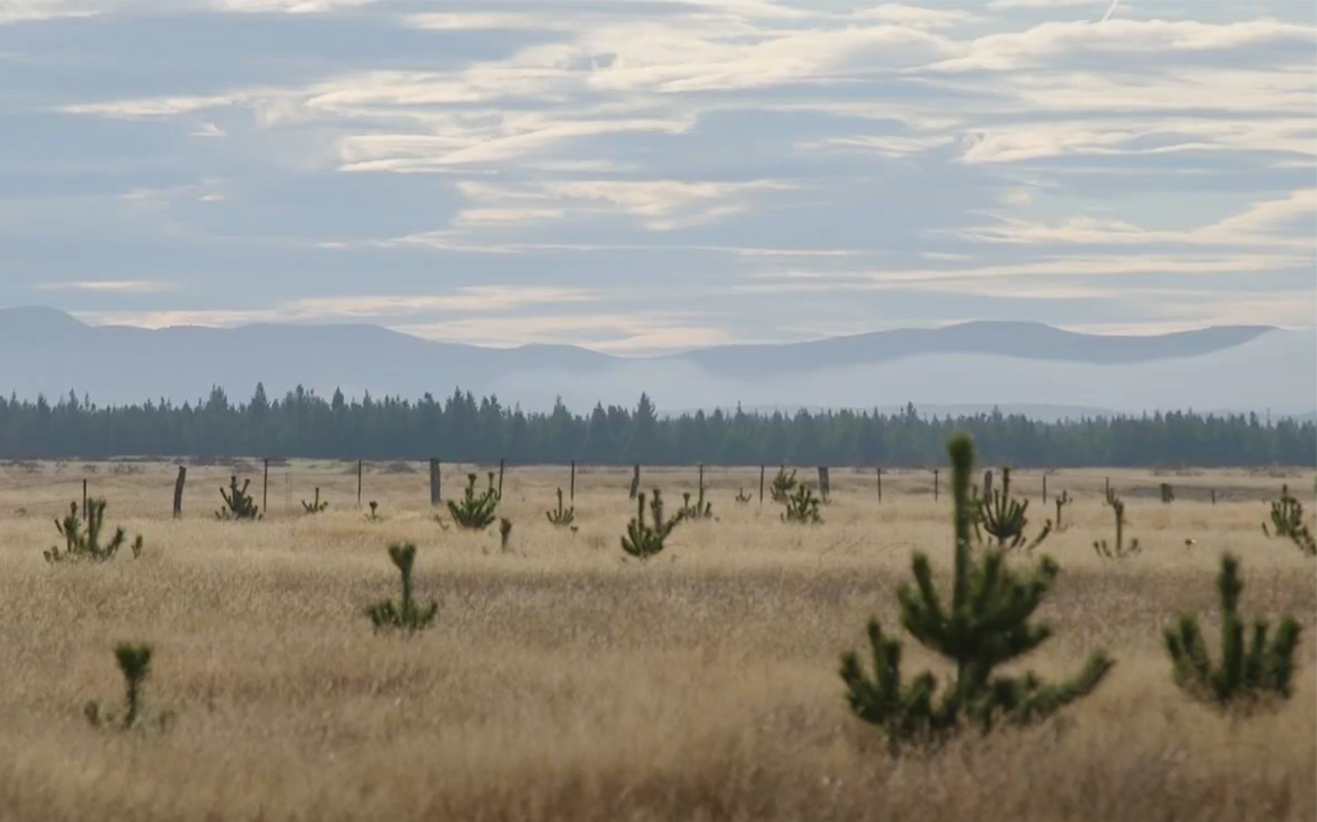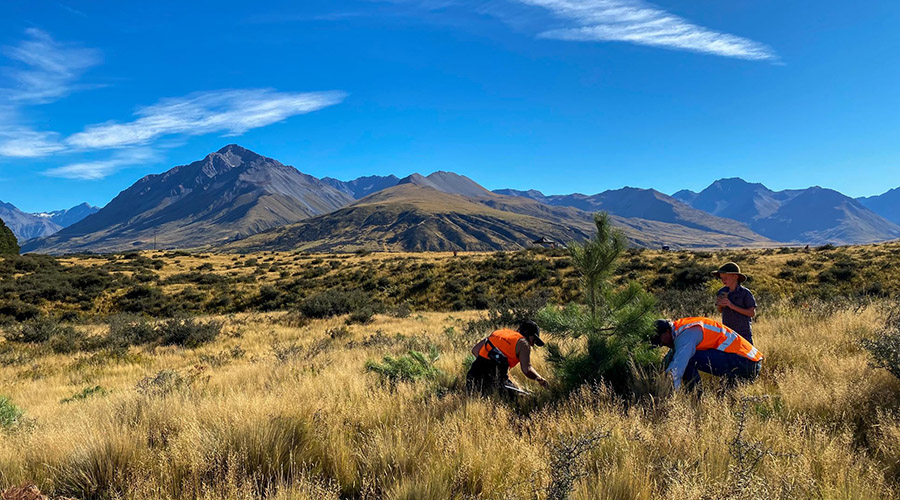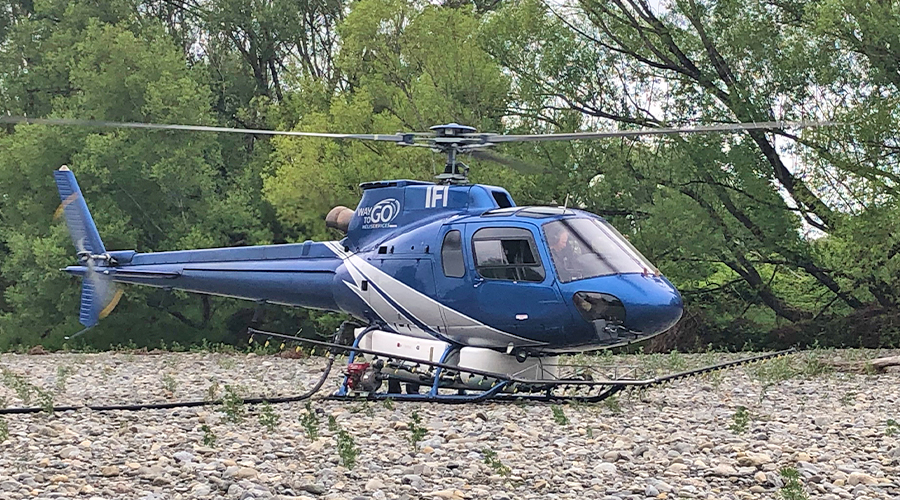Controlling wilding pines
Find out more about initiatives undertaken by us and our partners to control wilding pines, and learn how you can contribute to safeguarding the environment of Canterbury/Waitaha.
How we control wilding pines
We control wilding pines in Canterbury/Waitaha in 16 areas, called management units.
Our goals are to:
- remove wilding conifers from the landscape
- eliminate seed sources wherever possible
- transition the management of wilding pine control back to the landholder.
The National Wilding Conifer Control Programme (NWCCP) led by Biosecurity NZ was established in 2016 to ensure a collaborative, coordinated and effective approach to national wilding management.
Programme partners include central and local government, community stakeholder groups, mana whenua, researchers, industry and private landowners.
The NWCCP exists to deliver on the outcomes of the National wilding conifer management strategy 2015-2030 - its vision: to prevent the spread of wilding conifers and contain or eradicate established areas of wilding conifers by 2030.
Of the total known infestation area nationally (over 3 million hectares), around 70 per cent had received at least one round of control work by December 2022. Repeat control and ongoing maintenance are still needed to remove new growth from seeds already in the ground.
Please check our public notices page for upcoming wilding pine control work on public land.
Fighting climate change
While it is true that all trees, including wildings, do sequester carbon, wilding trees are not a helpful tool when it comes to achieving climate change targets because their negative impacts far outweigh their carbon-absorbing benefit.
Read more: Are wilding pines useful for fighting climate change? | mackenziewildingtrust.org
What you can do to control wilding pines
Anyone can join us in the fight against these invasive pests, here are some practical ways to get involved:
- Remove pest trees from your land. Identify pest species, select the best control method and choose replacement plants that won't cause problems for you and your neighbours.
- Remove wilding pine seedlings when you're hunting or hiking. Pull them out of the ground or cut small trees close to the ground removing all green material- they can be left on-site to break down naturally.
- Replace pest trees on your property with native plants or less spread-prone exotic species. Read the Right tree for your place guide (PDF file, 595 KB) for inspiration.
- Work with neighbours to control wilding pines that have spread across property boundaries.
- Get in touch with one of the fantastic community groups and help tackle the wilding pine problem locally.
- Businesses can sponsor community projects, take part in volunteer days and help spread the word.
If you have any questions about wilding pines, please contact our biosecurity team at 0800 324 636 or email biosecurity@ecan.govt.nz.
Wilding pine control methods
Which control method should I use?
Several factors will influence your decision about which control method to use:
- density and size of trees
- species
- site factors - terrain, access, surrounding vegetation.
- land use after control and your control objectives.
- resources at your disposal (ie budget, use of an experienced helicopter operator).
Ground control - manual labour or mechanical
Ground control is used on accessible sites that are either easy to walk or drive to. Manual labour is used for sparse to moderate wilding densities, while mechanical control is used for dense infestations.
- Hand-pulling, handsaws or loppers
- Chainsaws/felling
- Scrub-bar
- Drill and fill
- Ground-based basal bark application
- Mechanical (mulching or removal via a digger/bulldozer)
- Burning (subject to consent processes)
Aerial control- helicopters or drones
Aerial control with helicopters or drones is used for sites which are less accessible, have very sparse infestations, or are dense and cannot be mechanically controlled.
- Aerial basal bark application is good for scattered infestations of small to medium-sized trees, particularly if the site covers a large area. ABBA may also be used if the site is particularly steep or hazardous.
- Aerial foliar spray application is good for dense, closed canopy infestations. AFSA can also be used for spot spraying of scattered infestations of small to medium trees.
Replanting after control work
After wildings are removed from a site, it's common for exotic plant species to establish and thrive. If you want to avoid this, it's important to think about the vision for a site before you start your control activity. Your choice of control method can assist you with reaching your land-use goal.
You will need to determine which land-use type best suits the land and land tenure and consider the available seed sources of surrounding vegetation (native or introduced). It is also possible to initially transition the land to one land-use type (ie pasture) before converting it to another. All required resource consents should be obtained where needed. We also recommend you avoid planting any of the 10 species listed in the CRPMP.
Effective reforestation alternative
There are various choices available to prevent the reoccurrence of wilding pines on your land after successful control. Effective reforestation alternatives include restoring native plants, seeding pasture for grazing, planting non-invasive trees, and preserving tussock grasslands.
Restoring native plants
Restoring native plants can either be active or passive. Regardless of which technique (or combination of) is used, it's important to consider that wildings leave a legacy in the soil. This facilitates their reinvasion as well as other weeds at a site.
Therefore, weed and pest control will be needed to protect and encourage the establishment of native vegetation, especially through the first five years post-control.
Passive restoration
There needs to be a well-established native seed source means managing the site so that native restoration is encouraged and occurs without intensive support/replanting. It is essential there's a well-established native seed source near the site. The vegetation will likely revert to its natural surrounding cover (ie tussock grassland, or native shrubland) in time. Be aware this is a long-term process!
In situations where there is existing native shrubland or forest, using the drill and fill control method to control wilding pines will complement passive restoration as it will minimise any disturbance on the site. You will likely need to do some maintenance/weed control to remove any reemerging wildings or other invasive weeds that are established until native regeneration reaches a point of canopy closure or full ground cover.
Passive restoration is not recommended for tussock grassland sites where there is a significant wilding pine seed source remaining nearby.
Active restoration
Direct planting of native vegetation. It can be expensive and labour-intensive but is a significantly faster method of establishing native cover and is necessary for sites where there is no native seed source nearby.
To maximise survival rates, it is important to eco-source the seeds from local seed sources as they are best adapted to your conditions.
Allow sufficient time to source the native plants you need - it might take months or even a year for them to be a suitable size for planting, especially if you're ordering a large volume.
Plant protection like guards or weed matting is also recommended to help boost survival rates and reduce weed control requirements.
Seeding pasture for grazing
Seeding pasture for grazing can be a very effective land-use option to prevent reinvasion of wildings, in areas suited for pastoral land-use.
Mechanical control, logging, and mulching are effective control techniques that can allow for wilding tree sites to transition well into grazing paddocks. Be sure to apply for and get approval for the required resource consents. This land use type may not be suitable for all land tenures.
Planting non-invasive trees
You may want to plant an area in plantation forestry or plant amenity or shelter trees after you control wildings. This includes options for re-establishing shelterbelts that may have been producing wildings.
Make sure you plant non-invasive trees and follow normal good plantation establishment practices. District Councils may also have rules around what trees can be planted, so it is best to check and obtain consents where needed.
Wilding regeneration can be expected amongst planted trees and needs to be controlled.
Preserving tussock grasslands
Only suitable for areas where there were tussocks before wilding infestation.
If there is no nearby wilding pine seed source, it is possible to revert land back to tussock grasslands if that was the land cover before wilding infestation. However, tussock grasslands can often be invaded by many types of exotic grasses and woody vegetation, so vigilant maintenance and protection may be required.
Control requirements and responsibility
The Canterbury Regional Pest Management Plan (CRPMP) guides land occupiers based on factors like control operations, funding, distance to the boundary, and tree species.
The scenarios in the Wilding Conifer Rules (PDF file, 2.35MB) explain who is responsible under the CRPMP to manage wilding pines to prevent reinfestation on property.



